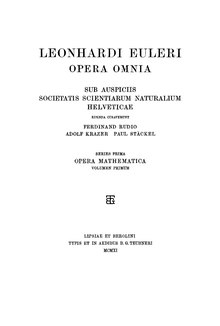Opera Omnia Leonhard Euler
 | |
| Author | Leonhard Euler |
|---|---|
| Original title | Opera Omnia Leonhard Euler, Series I, Volume 1 |
| Language | German, French, (Latin) |
| Genre | Non-fiction |
| Publisher | B. G. Teubner- Verlag, Leipzig - Berlin |
Publication date | 1911 |
| Media type | |
| Pages | 748 |
Opera Omnia Leonhard Euler (Leonhardi Euleri Opera omnia) is the compilation of Leonhard Euler's scientific writings. The project of this compilation has been undertaken by the 1908 established Euler Committee of the Swiss Academy of Sciences and is ongoing. The Committee decided on "the edition of the Collected Works of Leonhard Euler in the original languages, convinced of rendering the entire scientific world a service thereby."[1], and, in 1919, it indicated to collect “All works from Leonhard Euler, hitherto unseen or already printed, coming from St-Petersburg or elsewhere need to be integrated. This also includes the scientific letters of Euler”.[2] The project has been supported by the international community, notably the Petersburg Academy of Sciences where Euler taught and which lent out its Euler materials in 1910. Publishing Euler's Opera Omnia has been termed "one of the most extraordinary projects in publishing".[3]
Euler's writings[]
During his life, Euler published about 560 writings. After his death in 1783, the Petersburg Academy published more of his manuscripts until 1830 increasing the number of his publications to 756. Additional manuscripts were found later by his grandson Paul-Heinrich Fuss and published. Gustav Eneström established an inventory - the Eneström Index - between 1910 and 1913 listing 866 publications, namely E1 - E866. Euler's writings are in Latin, French, and German, some also in Russian and English. Attempts to compile all of Euler's writing had been made prior to the work of the Euler Committee.
The Committee has been publishing Euler's work since 1911.[4] The work was delayed by two World Wars and economic issues. In addition, in the second part of the 20th century, it became more difficult to find qualified editors dealing with Latin texts and German Kurrent handwriting.[5][3] Recent editions contain also more extensive footnotes. In 2005, the Committee decided that the final volumes would be digitalized rather than printed, and that, eventually, the whole Opera Omnia would be online for easy access.[2]
Series I - IV[]
In 2018, the Committee indicated that 76 of 81 volumes had been published in four series:[6] When series I to IVA will be completed, there will be 84 volumes with about 35,000 pages.[7]
- Series I: Opera mathematica (Mathematics), 29 volumes, completed.
- Series II: Opera mechanica et astronomica (Mechanics and Astronomy), 31 volumes.
- Series III: Opera physica, Miscellanea (Physics and Miscellaneous), 12 volumes, completed.
- Series IVA: Commercium epistolicum (Correspondence), 9 volumes
- Volume IVA/9 is the last printed edition of the Opera Omnia.[5] Additional scientific correspondences will be made available online.
- Series IVB: Manuscripts, to be published online.
Major collaborating institutions[]
- Swiss National Science Foundation
- Petersburg Academy of Sciences, later Academy of Sciences of the Soviet Union, since 1991 Russian Academy of Sciences, St. Petersburg, Russia
- University of Basel, Basel, Switzerland
External links[]
References[]
- ^ Andreas Speiser (December 1937). "Report of the Euler Commission". National Mathematics Magazine 12(3). p. 122-124. Retrieved December 29, 2021.
- ^ a b "Euler Committee of the Swiss Academy of Science - Statement". Swiss Academy of Science. n.d. Retrieved December 29, 2021.
- ^ a b Elizabeth Manus (November 14, 2012). "The 100-year publishing project". The Boston Globe. Retrieved December 31, 2021.
- ^ Online version of first published volume from 1911
- ^ a b Andreas Kleinert (2015). "Leonhardi Euleri Opera Omnia: Editing the works and correspondence of Leonhard Euler". ResearchGate. doi:10.4467/23921749PKHN_PAU.16.002.5258. Retrieved December 30, 2021.
- ^ "Opera Omnia Leonhard Euler". Euler Committee. 2018. Retrieved December 30, 2021.
- ^ NN. "Euler Committee of the Swiss Academy of Science". Swiss Academy of Science. Retrieved December 29, 2021.
- Leonhard Euler
- Mathematics books
- 18th-century Latin books
- Collections of letters